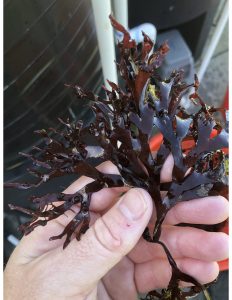"Epiphyte-host dynamics between Pyropia and Nereocystis in central California"
A Thesis Defense by Daniel J. Gossard
MLML Live-Stream | December 18, 2020 at 1 pm
Dan didn't really care for seaweeds until he started working at a seaweed farm in 2016 and everything changed. He realized that the complexity of these (primarily) sessile organisms requires lifetimes of study to even marginally understand, and that they're much more interesting than fish ever could be. His appreciation for the ecology of seaweeds grew as he realized that seaweeds can play an important foundational role for ecosystems. As seaweed biogeographic distributions have been known to rely on ocean temperatures, how will this foundational role change in reaction to a changing climate? What will be the trophic consequences? Can seaweeds potentially mitigate greenhouse (CO2 and methane) emissions? The answer is yes, but can the application be scaled in practical purposes on a global scale? Is seaweed farming a sustainable and scalable US industry that can alleviate the country's import deficit, feed livestock and fertilize fields, and be used as a biological filter to mediate industrial runoff alleviating the effects of eutrophication? (Yes). Despite all these pressing issues related to seaweeds, Dan chose to study an esoteric algal epiphyte for his Master's thesis. After graduating, Dan hopes to continue research in the fields of seaweed ecology and/or aquaculture.
Thesis Abstract:
Epiphytism is widespread in the marine environment across macroalgal taxa. However, despite being geographically ubiquitous, many unique epiphyte-host interactions remain poorly understood. Radiation within the bladed Bangiales (Rhodophyta), presumably brought on by a heteromorphic life history coupled with exceptional tolerance of stressors, led to many subtidal species of Pyropia occupying the epiphytic subtidal niche with their annual gametophyte stage. Pyropia nereocystis is a northeastern Pacific species that has evolved to primarily epiphytize the annual kelp Nereocystis luetkeana, which has a large latitudinal range from central California to the Aleutian Islands. There is a complete lack of tested hypotheses regarding the spatial and temporal dynamics of this epiphyte-host interaction and a lack of understanding of whether environmental heterogeneity drives recruitment and growth of Pyropia. I tested three aspects of Pyropia-Nereocystis epiphyte-host dynamics in the southern extent of the host’s range: (1) spatial and temporal variation in epiphtyte presence as a function host canopy densities at five sites for two cohorts; (2) empirical tests of the effects of depth on growth of gametophyte and sporophyte (conchocelis) life history stages through transplantation experiments; and (3) evaluation of the effects of depth and host characteristics on the recruitment and biomass of the ephiphyte over two seasons.
Pyropia epiphytism exhibited a shift in presence on Nereocystis that was attributed to an increase in the proportion of hosts that were epiphytized over the first two sampling periods. These dynamics differed interannually as a function of Nereocystis density. Additionally, testing the coefficient of variation of densities of epiphytized versus non-epiphytized Nereocystis over time (for sampling periods where Pyropia was present) indicated greater clumping of unepiphytized Nereocystis and more regularly arranged epiphytized Nereocystis. Pyropia gametophyte transplants showed no significant differences in growth when transplanted below their primary habitat (on the upper portions of Nereocystis stipes), but Pyropia conchocelis transplants showed a significant positive correlation between growth (change in area occupied) and depth. Intraregional environmental heterogeneity was reflected in significant intraregional differences among Nereocystis host characteristics that affected Pyropia recruitment. Additionally, significant associations between Nereocystis stipe characteristics and Pyropia's lower limit and abundance (biomass) were present for epiphytized Pyropia and their Nereocystis hosts. Nereocystis holdfast depth did not set the lower limit of Pyropia recruitment, but the PC (principal component) associated with longer host apophyses were correlated with a deeper Pyropia recruitment lower limit. Pyropia abundance in the upper meter was a strong predictor of Pyropia biomass on the whole Nereocystis stipe, but only during the peak period of Pyropia abundance. Furthermore, Pyropia abundance was positively correlated with the surface area of Nereocystis, hosts with longer stipes and more cylindrical apophyses, and thresholded by hosts characterized by greater SL:HD (stipe length:holdfast depth). These results suggest that the distribution of epiphytism of Nereocystis is more regular than it is clumped, gametophyte growth is not limited by depth, and that conchocelis can grow successfully depths at least up to 20 m. Additionally, in the presence of environmental heterogeneity, Pyropia may be regulated by Nereocystis stipe characteristics relating to host apophyses, stipe surface area, and ecological effects experienced by individual Nereocystis. The epiphyte-host interaction between the macroscopic stages of these heteromorphic algae highlights: (1) Nereocystis mediates Pyropia's persistence on a cohort sub-population scale, (2) Nereocystis likely influences Pyropia's abundance and lower limit by interactions on an individual host scale, and (3) Pyropia persists in the face of interannual hetereogeneity of host Nereocystis persistence.








